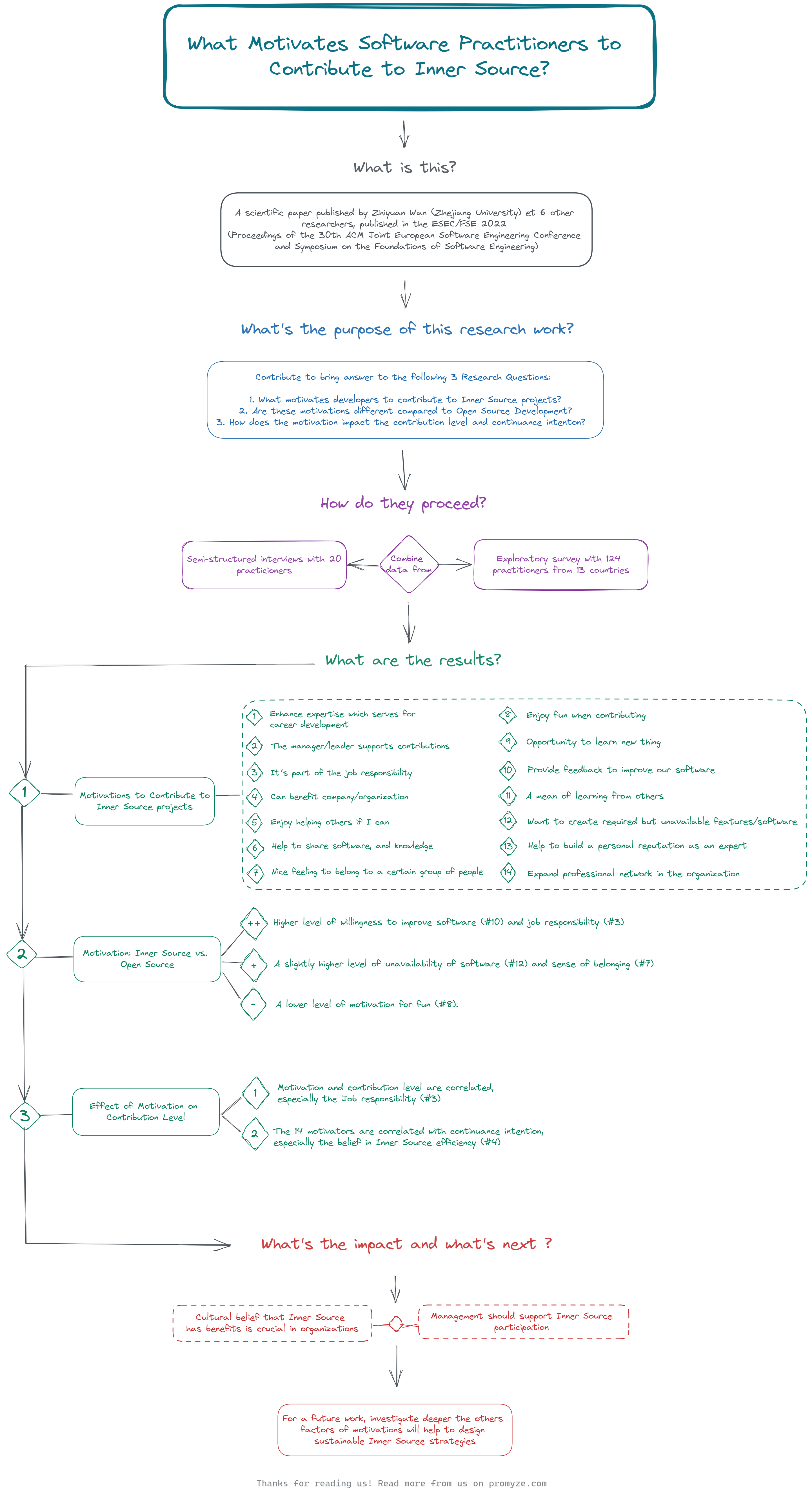
Developers’ motivations to contribute to Inner Source
In 2 recent blog posts, we discussed the benefits of Inner Source and its state in the industry in 2021. We recently identified a scientific paper published in late 2022 called What Motivates Software Practitioners to Contribute to Inner Source? by Zhiyuan Wan et al., published in the ESEC/FSE 2022 conference. The full paper is available here.
This post’s challenge is to provide a brief overview of the work done. We encourage you to read the paper to get more details on their work. Let’s try that.
What’s the purpose of the research work?
The authors claim that existing research has addressed the challenges of Inner Source adoption, as well as tools, models, and frameworks to support it. The paper includes 74 bibliographic references about previous work on Inner Source. In this work, they investigate the developers’ motivations in contributing to Inner Source projects.
In particular, 3 research questions are addressed:
- What motivates software practitioners to participate in Inner Source projects?
- How does the motivation of software practitioners differ when they contribute to Inner Source development compared with Open Source development?
- How does motivation influence the contribution level and continuance intention of software practitioners in inner source development?
How do they proceed?
They combine data from:
- Semi-structured interviews with 20 Inner Source practitioners having an average of 8.1 years of experience;
- An exploratory survey with 124 practitioners from 13 countries, having at least once experience in Inner Source development.
What are the results?
#1 They identified 14 motivations to contribute to Inner Source
Separated into 3 categories:
- 11 are internal (I) (when people stand behind a behavior out of their interests and values);
- 2 are external (E) (when people do a behavior for reasons external to the self);
- 1 is neither internal nor external (O).
So the vast majority of motivations are internal.
Among the 14 motivators, items #4, #5, and #6 are the top 3 motivators.
- Enhance expertise which serves for career development (I)
- The manager/leader supports contributions (E)
- It’s part of the job responsibility (E)
- Can benefit my company/organization (I)
- Enjoy helping others if I can (I)
- Help to share software, and knowledge (I)
- Nice feeling to belong to a certain group of people (I)
- Enjoy fun when contributing (I)
- Opportunity to learn new things (I)
- Provide feedback to improve our software (I)
- A mean of learning from others (I)
- Want to create required but unavailable features/software (O)
- Help to build a personal reputation as an expert (I)
- Expand professional network in the organization (I)
#2 Motivation in Inner Source vs. Open Source
Based on a recent study on motivations for contributing to Open Source projects, they’ve identified 3 main differences between Inner Source vs. Open Source, from the Inner Source perspective:
- Higher levels of motivation due to the willingness to improve the software (#10) and the job responsibility (#3);
- A slightly higher level of unavailability of software (#12) and sense of belonging (#7);
- A lower level of motivation for fun (item #8).
#3 Motivation on contribution level and continuance intention
Not so surprisingly, they find correlations between motivation and contribution level. Job responsibility (#3) is the most positively correlated.
All 14 motivators are positively correlated with continuance intention. The belief in the effectiveness of inner source motivation (#4) shows the greatest correlation with continuance intention among the 14 motivators. The job responsibility (#3) has the weakest correlation.
What does this work involve?
90% of the survey respondents agree that they contribute to Inner Source projects because they’re convinced it benefits their company/organization (#4). Thus, the cultural shift for adopting inner source development may directly impact the success and sustainability of inner source projects.
Organizations should provide support, resources, and flexibility to practitioners in order to retain contributors and enable Inner Source communities to flourish.
What future work?
They want to investigate other factors that impact practitioners’ contribution and continuance intention in Inner Source project. This will help to design strategies to sustain and grow inner source development.
The Big Picture
You can find more content on Inner Source patterns and best practices on that link.
Feel free to leave us any feedback if you appreciated this post 😉
